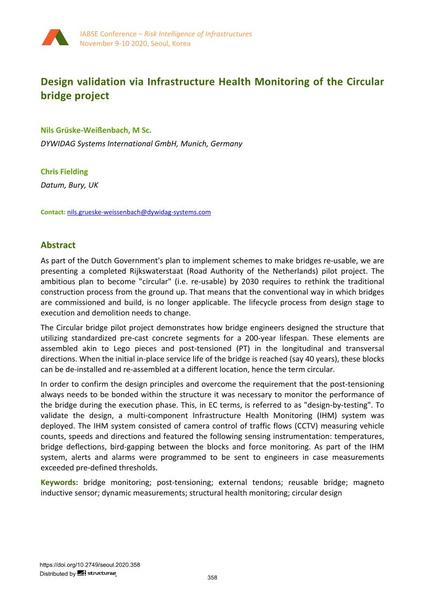Design validation via Infrastructure Health Monitoring of the Circular bridge project

|
|
|||||||||||
Bibliographic Details
| Author(s): |
Nils Grüske-Weißenbach
(DYWIDAG Systems International GmbH, Munich, Germany)
Chris Fielding (Datum, Bury, UK) |
||||
|---|---|---|---|---|---|
| Medium: | conference paper | ||||
| Language(s): | English | ||||
| Conference: | IABSE Conference: Risk Intelligence of Infrastructures, Seoul, South Korea, 9-10 November 2020 | ||||
| Published in: | IABSE Conference Seoul 2020 | ||||
|
|||||
| Page(s): | 358-363 | ||||
| Total no. of pages: | 6 | ||||
| DOI: | 10.2749/seoul.2020.358 | ||||
| Abstract: |
As part of the Dutch Government's plan to implement schemes to make bridges re-usable, we are presenting a completed Rijkswaterstaat (Road Authority of the Netherlands) pilot project. The ambitious plan to become "circular" (i.e. re-usable) by 2030 requires to rethink the traditional construction process from the ground up. That means that the conventional way in which bridges are commissioned and build, is no longer applicable. The lifecycle process from design stage to execution and demolition needs to change. The Circular bridge pilot project demonstrates how bridge engineers designed the structure that utilizing standardized pre-cast concrete segments for a 200-year lifespan. These elements are assembled akin to Lego pieces and post-tensioned (PT) in the longitudinal and transversal directions. When the initial in-place service life of the bridge is reached (say 40 years), these blocks can be de-installed and re-assembled at a different location, hence the term circular. In order to confirm the design principles and overcome the requirement that the post-tensioning always needs to be bonded within the structure it was necessary to monitor the performance of the bridge during the execution phase. This, in EC terms, is referred to as "design-by-testing". To validate the design, a multi-component Infrastructure Health Monitoring (IHM) system was deployed. The IHM system consisted of camera control of traffic flows (CCTV) measuring vehicle counts, speeds and directions and featured the following sensing instrumentation: temperatures, bridge deflections, bird-gapping between the blocks and force monitoring. As part of the IHM system, alerts and alarms were programmed to be sent to engineers in case measurements exceeded pre-defined thresholds. |
||||
| Keywords: |
post-tensioning structural health monitoring dynamic measurements external tendons bridge monitoring reusable bridge magneto inductive sensor circular design
|
||||
